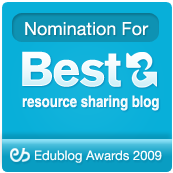By Noah Geisel (
@SenorG)
Others on this blog have been writing about student-produced/student-driven final exams. I'd like to add to the conversation the student-produced final review. This is the third semester that I have foregone handing out a big semester review before the final and instead left it up to my students to guide the review and I have not been disappointed. Just as there is a wide range of abilities in my classes, students produce an array of activities that go far beyond what I would have created, especially on the high and low ends of ability/readiness. I would be lying if I claimed that 100% of students subsequently took advantage of class review time to diligently study and prepare for the final exam but the vast majority do and, from my viewpoint, appear much more engaged in the whole process. I
think that the student ownership creates buy-in and interest in what we are doing.
Note that while this is for high school Spanish students, most of the tools and resources here can be adapted to meet the needs of other subjects. This year, the most popular and beneficial study guides came in the form of the dice maker, fakeconvos.com, awards show and Quizlet. Below is an abbreviated version of how I introduce this to classes (I post it to them on Edmodo, and those who create digital reviews share them with classmates on the group page):
One of the ways that you can demonstrate your own understanding of learning is to be able to show it or teach it to another student. To that end, you will help others study for the final exam (and they will help you) by creating a review activity or game. We will dedicate block day and Friday to preparing for the final exam by using YOUR review activities.
You must be able to explain the game to your peers. If you are unsure about your idea, run it by me before your create it. You may do more than one activity. If you have a bigger project to attempt, I am open to allowing you to work in pairs but clear it with me first. Same goes for any doubts you have...if you have questions, ask!
Some ideas:
1. Write stories that classmates can read. By reading them, they are studying and preparing for the test.
http://www.artisancam.org.uk/flashapps/superactioncomicmaker/
www.makebeliefscomix.com
2. Record a listening practice. You can record a reading of one of our stories from class (They will be in your edmodo library) and have questions that classmates answer to demonstrate their listening comprehension.
3. Adjust one of these games to meet your needs:
http://its.leesummit.k12.mo.us/gameresources.htm
4. This site is a gold mine of activities you can use: awards certificate maker to do your own awards show for classmates, dice games, board game generator to invent your own board game, crossword puzzles and more. A lot of you used this one last semester:
http://www.toolsforeducators.com/
5. Create a story (usng target vocab!) in the form of a fake Facebook conversation:
http://fakeconvos.com/index.php
6. Here's another site with great resources, including a Jeopardy game maker:
http://www.superteachertools.com/index.php
7. Make your own online review game!
http://www.purposegames.com/
8. Make your own poster series (Hola meme addicts!). This site has some good resources:
http://bighugelabs.com/
9. Create a stack of digital flash cards. There are a ton of resources out there. Here's one:
http://www.brainflips.com/
10. This is a step up from a dice game: Sentence Generator
http://www.education.vic.gov.au/languagesonline/games/sentence/
This is but a partial list of what resources are out there. What would you add to the list? Have you had success (or struggle) with tasking students to take ownership of their own final review? Let us know in the comments!










